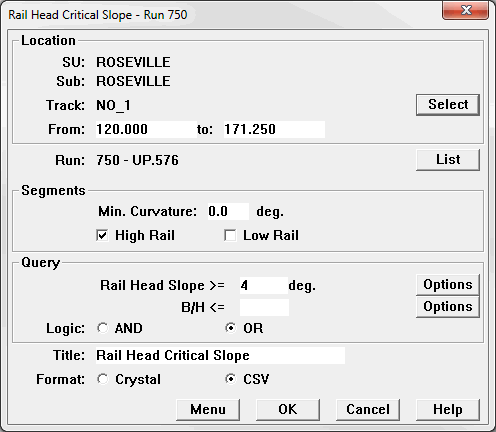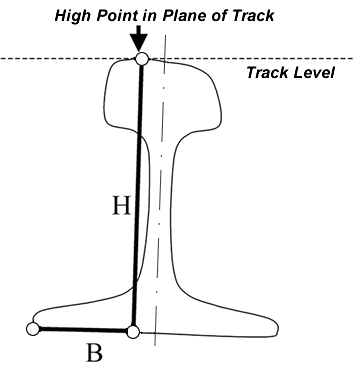
The rail head slope query searches for rail profiles meeting specified criteria for rail head slope and base-to-height ratio, parameters that are related to rail rollover potential. To run it, first select a profile run, then choose Rail Head Slope... from the Run menu of the Profile View window. Choose Run/Profile/Rail Head Slope... from the Profile View window menu.

Rail Head Slope Query dialog
The location will default to the currently selected run. You may click the Select button to select a different track within the territory; you can also restrict the mileage range in the From: and To: fields. The current run will appear as the default run. You can select another run within the territory by clicking the List button. If a value is entered in the Min. Curvature field, only curves exceeding the specified curvature will be included in the query. If this field is left blank, all track segments, curve and tangent, are included. The High Rail and Low Rail check boxes may be used to restrict the query to either the high rail or the low rail of curves.
Query values may be entered for Rail Head Slope, for B/H or for both. If both are entered and AND logic is used, a profile will be selected only if it meets both criteria. If OR logic is used, a profile will be selected if it meets either criterion.
Rail head slope is the angle of a specified test zone of the rail head profile, compared to a line perpendicular to the rail centerline. The test zone is defined by a user-selected distance to the gauge side and field side of the centerline. It is specified from the Options button beside the Rail Head Slope field.

Rail Head Slope
B/H is base-to-height ratio. Height is measured from the high point of the worn rail head in the plane of track to a point bx on the bottom surface of the rail base, along a line parallel to the rail centerline. Base is measured from the point bx to the field-side edge of the rail base, along the underside of the rail base.

B/H can optionally be measured either with the profile in its "as found" orientation or after rotating the profile so as to correct its cant angle. Which selection should be used depends on the primary purpose of the query. Use the Options button beside B/H to change the selection.
If the query is run prior to track work which is expected to correct rail cant in deficient areas, then the results after cant correction may be more important than the results "as found". If rail is canted to the field side long enough to wear conformally, then set upright, the high point of the rail head may move far to the field side, producing an unhealthily low B/H. The option to measure B/H after cant correction is intended to capture this possibility.
On the other hand, if current track conditions are the main concern, it may be better to calculate B/H from the high point using rail cant "as found".
To run the query, click OK after entering all query conditions. When the query is complete, the first selected profile is displayed. Profiles can be navigated using the Query Browse Dialog.
The Reports button in the Query Browse Dialog allows you view the query results as a Crystal report, which can be printed or saved as a Microsoft Word document, PDF or Microsoft Excel file. If you wish to save the query template to the map Reports menu, click Menu.
If the query has been run from the map interface, the locations at which the query returns results will be shown in color on the map. A menu with the corresponding color will also appear in the map side menu view. Click on this menu to Hide, Bring to Top, View or Report. The Report menu allows you to select a Crystal or CSV report format.